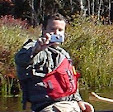 |
| The crew - loaded up and ready to go |
Baskehegan Stream arises in Carroll, ME and flows generally north for around 40-miles to Bancroft where it joins the Mattawamkeag River. We would be paddling the section through Baskehegan Lake from White Farm Road in Topsfield to the dam in Danforth. Originally, the plan was to paddle down to the bridge in Bancroft, but more on that later.
 |
| Put in on White Farm Road |
White Farm Road is a dirt logging road owned by a local logging company. The put in is just below a bridge and a pretty waterfall. After unloading our boats and gear we ran the shuttle up to Bancroft. We finally got on the water at around 4:00.
 |
| Wading through the shallows |
We unloaded our gear and quickly got the tarp and tents set up. We gathered wood as Jonathan prepared dinner – his classic fried fish with Maine guide potatoes. After dinner we sat around the fire until 9:45 when we called it a night.
 |
| Beaver lodge in the Big Bog |
We got on the water around 11:00 for our trip through Big Bog – the large wetland that feeds Baskehegan Lake. There were beaver lodges everywhere, but surprisingly few birds or other wildlife. The river twisted and turned through a marsh with very little solid ground. We took a break for lunch in our boats.
 |
| Crossing to Long Island |
The rain and fog continued as we set up camp. By 6:00, tents and tarps were up, and wood was gathered. Time for cocktails. Dinner was Ellen’s chili, and desert was Jules’ brownies. It was another early night. I was in the tent around 9:30.
 |
| Tents with extra tarps for the rain |
I finally crawled out of my tent around 7:30 when I heard Jonathan lighting the fire and making coffee. We cooked breakfast and started taking down camp in the rain. We finally got on the water at around 11:00. This was to be our biggest paddling day – around 12-miles down to the Narrows Campsite on Crooked Brook Flowage. We would be paddling into 10-mph headwinds with gusts around 25-mph.
 |
| Crossing to Round Island |
We ran the broken dam as we left the lake and reentered the river. We continued to fight a strong headwind as the river twisted and turned thorough another large wetland. We were cold and tired when we pulled into the Anvil Meadows Campsite for a break at around 3:00. Rather than paddling on, we decided to call it a day. Day 3 paddling – about 8 miles, about 4 miles short of our goal.
 |
| Tarp is up at Anvil Meadows |
Tuesday was the first morning that the rain didn’t keep me in the tent. I got up around 6:00, started the fire and the coffee, and started taking down my tent. With the truncated day on Monday, we knew that we needed to get an early start today. We had a quick breakfast, broke down camp and loaded the boats for the final leg of our trip. We are on the water at around 8:30.
 |
| Running the small rapids |
We crossed the flowage, and paddled along the shore down to the Danforth Dam into a 15-mph headwind with gusts around 30-mph. It was a real slog. We pulled into the boat ramp at around noon. Day 3 paddling – around 7-miles.
 |
| Take out at Danforth Dam |
This trip was definitely a case of Type 2 Fun. It was cold, cloudy, windy and rainy. We spent most of our time cold and wet. We were paddling heavily-loaded boats through shallow water and against strong headwinds. But in the end, we pulled together and made it work. We only paddled 26-miles total, but the camping and comradery was still great.










